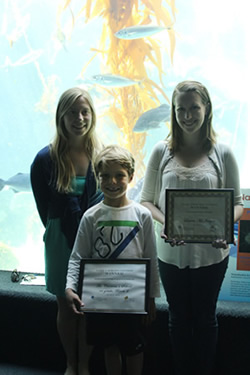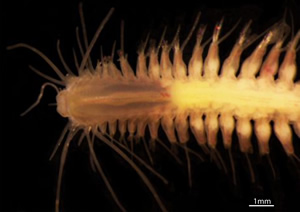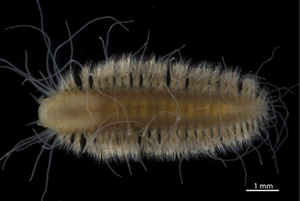New Species of Deep-sea Worms Named as Part of Contest
Jessica Crawford | June 13, 2011

Scripps scientist Mindi Summers, who was part of the
team that discovered the deep-sea worms, congratulates winners Laura
McIntyre (right) and Theodore Marx, who initially suggested the winning name
for his first-grade classroom at The Children's School in La Jolla.
Fuzzicawuzzicus
Hispidafigulus
Imapickyeaterincali
Ask the public’s help in naming two new species of deep-sea worms, and you’re bound to get a few off-the-wall suggestions. These were some of the unique names submitted for Birch Aquarium at Scripps’ Name a Species Contest, which concluded last week.
After a week of online voting, a teenager from San Marcos and a first-grade classroom from La Jolla were chosen by the public to name the worms, recently discovered by researchers at UCSD's Scripps Institution of Oceanography. The winning names were announced at Birch Aquarium on World Oceans Day, June 8. They will become the official scientific names of the species.
Laura McIntyre, 19, from San Diego, will name the deep-sea worm belonging to the genus Vrijenhoekia. McIntyre submitted the species name ketea, the Latin word for “sea monsters.” A first-grade classroom at The Children’s School in La Jolla was selected to name the second worm belonging to the genus Podarkeopsis. Students submitted the species name falenothiras, the Greek word for “whale hunter.”
“The more you can do to get the word out about marine animals, the better it is,” said McIntyre, who learned about the contest from a newspaper article. “I thought it was a really awesome way to do it for World Oceans Day.”

Podarkeopsis falenothiras
Traditionally, the person who first describes a newfound plant or animal is entitled to name it, but Scripps invited the public to share in the process. In May, more than 165 species names were submitted for the two worms. Names were received from 22 states as well as from Greece and Taiwan. Participants were asked to follow proper naming conventions as detailed in the International Code of Zoological Nomenclature, as well as provide a description of how they came up with their suggestion.
Scientists from the Scripps Marine Invertebrate Phylogenetics Lab, who discovered the species, selected three finalists for each species. Last week, more than 1,100 votes were cast for the finalists. Votes came in from a dozen countries, including Indonesia, Italy, Japan and South Africa.
“I thought it was a great opportunity to teach (the students) about how scientists name things, and they were all very excited,” Children’s School first-grade teacher Kim Lohnas said.
Scripps scientists, in association with the Monterey Bay Aquarium Research Institute, discovered the worms living upon whale carcasses that had fallen to the ocean floor off Monterey, Calif. These “whale falls” spawn unique communities of marine animals that can feed off the carcass for decades.

Vrijenhoekia ketea
The worms, which measure only a few centimeters in length, are part of the family Hesionidae. Only 10 hesionids have been described from the deep sea, and only one has been described from a whale fall. In total, Scripps scientists discovered six new species of worms on whale falls.
First envisioned in 1992 at the Earth Summit in Rio de Janeiro, World Oceans Day is an annual opportunity to honor our ocean and personal connection to the sea.
For more information about World Oceans Day and the Name a Species Contest, visit aquarium.ucsd.edu.

|